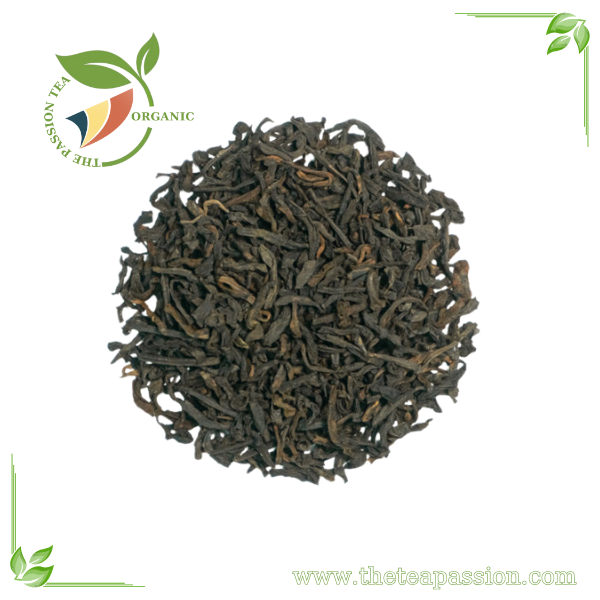PEKOE (PEK)
Pekoe (PEK): Tender Leaves, Smooth Texture, and Natural Twisting
Tea is one of the oldest and most popular beverages in the world, with a wide variety of types and processing styles. Among these, Pekoe tea (abbreviated as PEK) stands out as a special kind, cherished for its tender leaves, smooth texture, and distinctive natural twisting. Pekoe is not merely a term within the tea industry but also symbolizes refinement, quality, and artistry in the harvesting and processing of tea leaves.

What is Pekoe?
Pekoe refers to the first flush of young tea leaves picked from the tea plant. These are the youngest and most delicate leaves, usually the first or second leaf on the tea bud, characterized by their small size and fine texture. Pekoe tea leaves have a smooth, silky surface and maintain a gentle natural twist, creating a unique shape that distinguishes them from other types of tea leaves.
The term “Pekoe” originates from ancient Chinese, meaning “white hair” or “white down,” referring to the tiny fine hairs that cover the young tea buds. This fine fuzz not only protects the leaves from external factors but also contributes to the tea’s pure and delicate aroma.
Distinctive Characteristics of Pekoe Tea Leaves
Pekoe tea leaves possess several distinctive features that make them highly valued in the production of premium teas:
- Tender and Soft Leaves: As the youngest leaves, Pekoe leaves have a delicate texture that is easy to process and retains the tea’s natural flavor.
- Smooth Surface: The leaves have a smooth, unblemished surface that helps preserve the leaf’s essential oils and flavor compounds.
- Natural Twisting: During harvesting and processing, Pekoe leaves maintain a gentle natural twist that enhances their appearance and helps retain aroma longer.
- Fine White Hairs: The presence of tiny white hairs on the buds adds visual appeal and protects the leaf during growth.
The Role of Pekoe Leaves in Tea Production
Pekoe leaves play an essential role in the production of various types of tea, especially high-quality black, green, and oolong teas. Being the youngest part of the tea plant, they are rich in nutrients and aromatic compounds, which results in teas with refined flavors, vibrant colors, and pleasant aromas.
- Flavor Quality: Young leaves contain higher amounts of essential oils and polyphenols, which contribute to the complex aroma and smooth taste.
- Leaf Durability: The natural twist helps leaves maintain their shape and quality during transport and storage.
- Aesthetic Appeal: Properly processed Pekoe leaves have a bright color, shiny surface, and uniform twist, increasing their market value.
Harvesting and Processing Pekoe Leaves
To obtain high-quality Pekoe tea leaves, the harvesting and processing stages require precision and care.
Harvesting
Pekoe leaves are handpicked selectively, choosing only the youngest buds without damaging them. Harvesting is usually done early in the morning when dew is still present, which helps preserve the freshness and aroma of the leaves.
Processing
After harvesting, the leaves undergo different processing steps depending on the type of tea being produced:
- Black Tea: Leaves are withered, gently rolled to create twists, fully oxidized until they turn a reddish-brown color, then dried.
- Green Tea: Leaves are quickly steamed or pan-fired after picking to prevent oxidation and preserve the green color and fresh flavor.
- Oolong Tea: Leaves are partially oxidized, striking a balance between green and black tea characteristics.
Cultural Significance and Economic Value of Pekoe Tea
Pekoe tea is more than just an agricultural product; it is a cultural symbol in many tea-growing countries such as China, India, Sri Lanka, and Vietnam. It is often used in traditional tea ceremonies, representing elegance and sophistication in tea appreciation.
Economically, Pekoe tea commands a higher price on international markets due to its labor-intensive harvesting process, high quality, and superior taste. Its rarity and premium status make it a sought-after product among tea connoisseurs worldwide.

How to Properly Enjoy Pekoe Tea
To fully appreciate the delicate flavor and essence of Pekoe tea, tea drinkers should consider the following:
- Water Temperature: Use water heated to about 85-90°C (185-194°F) to avoid destroying the natural aroma.
- Steeping Time: Brew for 2-3 minutes to extract a rich flavor without bitterness.
- Brewing Vessel: Use a clay or porcelain teapot to retain heat and enhance the tea’s taste.
- Tasting: Sip slowly, savoring the sweet aftertaste and the gentle fragrance lingering in the mouth.
Classification and Grades of Pekoe Tea
Within the tea industry, Pekoe is further classified into various grades based on leaf size, tenderness, and degree of twist:
- Orange Pekoe (OP): Medium-sized young leaves, usually second or third leaf with slight twisting.
- Flowery Pekoe (FP): Includes buds with one or two young leaves, often covered with more white fuzz.
- Golden Pekoe (GP): Leaves with a light golden hue due to special processing, offering a stronger flavor.
- Pekoe Souchong (PS): Larger leaves with a distinct twist and bold flavor, commonly used in black teas.
These classifications help producers and consumers identify the quality and characteristics of different Pekoe teas.
Health Benefits of Pekoe Tea
Beyond its delightful taste, Pekoe tea offers numerous health benefits thanks to its rich content of antioxidants, polyphenols, and natural nutrients:
- Immune Support: Compounds in tea boost the immune system and help fight illnesses.
- Digestive Aid: Pekoe tea improves digestion and reduces bloating.
- Stress Relief: The gentle aroma and warmth promote relaxation and reduce stress.
- Weight Management: Regular consumption can enhance metabolism and support healthy weight control.
Tips for Proper Storage of Pekoe Tea
Maintaining the quality and aroma of Pekoe tea requires careful storage:
- Avoid Direct Light: Store tea in airtight containers away from sunlight to preserve fragrance.
- Keep Dry and Cool: High humidity can cause mold and degrade quality.
- Prevent Odor Absorption: Tea easily absorbs surrounding odors, so keep it away from strong-smelling foods.
Use Within Optimal Time: For best flavor, consume Pekoe tea within 6 months to 1 year from harves
